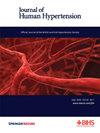体育活动、体位血压反应和亚临床动脉粥样硬化之间的关系:瑞典心肺生物图像研究(SCAPIS)。
IF 3.4
4区 医学
Q2 PERIPHERAL VASCULAR DISEASE
引用次数: 0
摘要
站立时血压(BP)异常反应与动脉粥样硬化性心血管疾病(CVD)有关。体力活动(PA)对直立性bp反应的作用及其与亚临床动脉粥样硬化的关系尚不清楚。我们的目的是评估PA与直立性bp反应之间的关系,以及PA是否改变直立性bp反应与亚临床动脉粥样硬化之间的关系。基于人群的scapis研究共纳入5396名中年受试者。使用线性回归研究了直立bp响应和加速度计衍生的PA之间的关系。采用冠状动脉钙化评分(CACS)评价PA对直立性bp反应与亚临床冠状动脉粥样硬化之间关系的调节作用。在调整年龄、性别、总穿着时间、周末天数比例和季节后,中度至重度PA (MVPA)与不太明显的直立性收缩压(SBP)升高相关,但与更明显的直立性舒张压升高相关(每增加1%的Beta值(mmHg):0.12;p =本文章由计算机程序翻译,如有差异,请以英文原文为准。

The relationship between physical activity, orthostatic blood pressure reactions and subclinical atherosclerosis: the Swedish CArdioPulmonary bioImage Study (SCAPIS)
An abnormal blood pressure (BP) response on standing is associated with atherosclerotic cardiovascular disease (CVD). The role of physical activity (PA) on orthostatic BP-reactions and its relation to subclinical atherosclerosis is unclear. We aimed to assess the association between PA and orthostatic BP-reactions, and whether PA modifies the relationship between orthostatic BP-reactions and subclinical atherosclerosis. A total of 5,396 middle aged subjects from the population-based SCAPIS-study were included. Associations between orthostatic BP-response and accelerometer-derived PA were studied using linear regression. Interaction analyses were performed to study modifying effects of PA on the relationship between orthostatic BP-response and subclinical coronary atherosclerosis, assessed by coronary artery calcium score (CACS). Moderate to vigorous PA (MVPA) was associated with less pronounced orthostatic systolic BP (SBP) increase but more pronounced orthostatic diastolic BP increase after adjusting for age, sex, total wear time, proportion weekend days and season (Beta per 1%-increase(mmHg):0.12; p = <0.01 and −0.06; p = 0.02, respectively). Subjects with high MVPA were less likely to have orthostatic hypertension (OHTN), but more likely to have orthostatic hypotension (OH; p = 0.002 for both). Individuals with higher CACS were more likely to have OH (p = 0.041) but not OHTN (p = 0.276). There were no interactions of PA on the association between orthostatic BP-response and CACS. In conclusion, physically active middle-aged individuals are less likely to show inappropriate SBP-increase upon standing, but more likely to have excessive SBP-decrease. PA does not modify the association between orthostatic BP-response and subclinical atherosclerosis. The relationship between PA, orthostatic BP and CVD is likely to be complex.
求助全文
通过发布文献求助,成功后即可免费获取论文全文。
去求助
来源期刊

Journal of Human Hypertension
医学-外周血管病
CiteScore
5.20
自引率
3.70%
发文量
126
审稿时长
6-12 weeks
期刊介绍:
Journal of Human Hypertension is published monthly and is of interest to health care professionals who deal with hypertension (specialists, internists, primary care physicians) and public health workers. We believe that our patients benefit from robust scientific data that are based on well conducted clinical trials. We also believe that basic sciences are the foundations on which we build our knowledge of clinical conditions and their management. Towards this end, although we are primarily a clinical based journal, we also welcome suitable basic sciences studies that promote our understanding of human hypertension.
The journal aims to perform the dual role of increasing knowledge in the field of high blood pressure as well as improving the standard of care of patients. The editors will consider for publication all suitable papers dealing directly or indirectly with clinical aspects of hypertension, including but not limited to epidemiology, pathophysiology, therapeutics and basic sciences involving human subjects or tissues. We also consider papers from all specialties such as ophthalmology, cardiology, nephrology, obstetrics and stroke medicine that deal with the various aspects of hypertension and its complications.
 求助内容:
求助内容: 应助结果提醒方式:
应助结果提醒方式:


